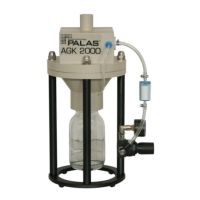4 Operation and settings
5935-en_V2.0_09/19 19
4.7 Aerosol substances
The aerosol generator AGK 2000 has been developed especially for the
generation of KCl-aerosols out of a KCl solution. Principally, the generator is
also suitable for the dispersion of pure liquids and suspensions. Thereby, the
user has to pay attention to the nozzle being cleaned carefully with a suitable
solvent when the liquid is changed. Otherwise the nozzle could be blocked.
Exchange of
liquids
When changing from a watery liquid to an oily one, observe the following:
1. The generator must be cleaned carefully with distilled water in order to
remove all salt residues.
2. The generator must be dried.
Then, it may be run with the oily aerosol substance.
If the change of aerosol substances shall be done from an oily liquid to a watery
one, observe the following:
1. The generator has to be cleaned carefully with a suitable solvent first.
2. The user has to pay attention to the generator being totally dry and
degreased.
4.8 Working with KCl-solutions
Note
The generator should not be run with a NaCl-solution of more than 10%
concentration for a time period longer than 8 h). This could evoke that the
nozzle gets blocked with crystalized KCl particles.
After every operation with the generator it must be cleaned with distilled water:
► This is done by running the generator at a pre-pressure of 4 bar for a short
period of time in order to clean the atomizer nozzle.
When running the generator with a watery KCl solution, this liquid is dispersed
in very fine droplets by the atomizer nozzle. Due to the use of dry pressurized
air, a great part of water in each droplet is evaporated already during the
process of generation. The remaining water evaporates inside the cyclone
separator, so that the aerosol leaving the generator may be called a dry
aerosol.
Particle size
distribution
The following table shows the impact of the KCl-concentration on the produced
particle size distribution (qualitatively). A lower KCl-concentration means shifting
the particle size distribution towards smaller particle diameters.
• Particle number distribution (dlogDp)
• KCl-solution (20 weight %)
• 4 bar pre-pressure
• measurement time: 1 min.
• measurement device: Palas PCS-2000

